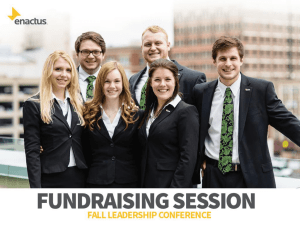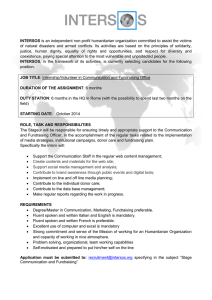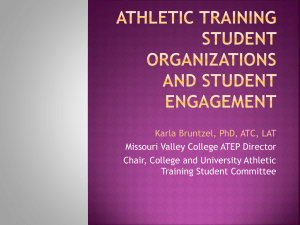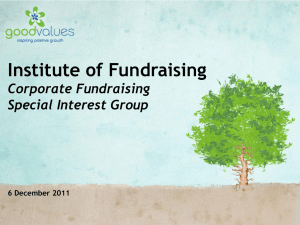Do Government Grants to Private Charities Crowd Out Giving or
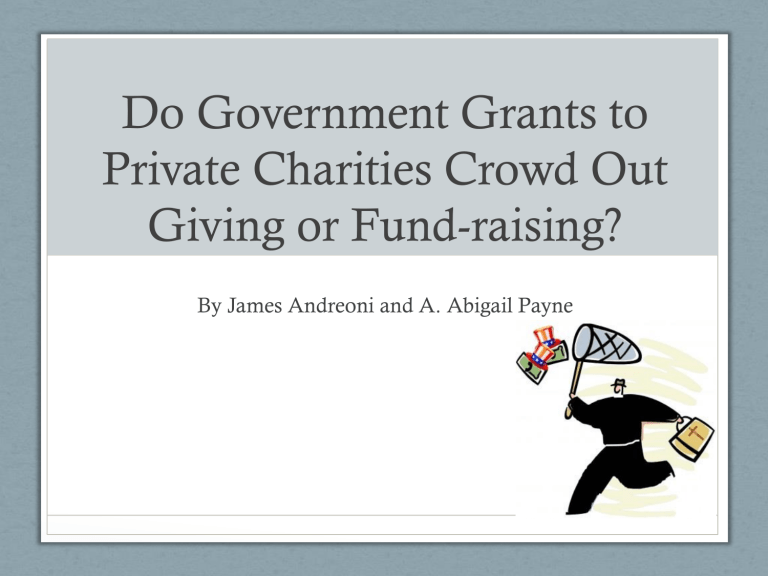
Do Government Grants to
Private Charities Crowd Out
Giving or Fund-raising?
By James Andreoni and A. Abigail Payne
When the government makes a grant to a private charitable organization, does it displace private giving?
• Rather than just accepting the common theory on government grants and the “crowding out” effect
(people view their tax dollars as substitutes for private donations) this paper examines a second explanation for crowding out. They test the theory that increases in government grants result in decreased fundraising efforts which subsequently results in a decrease in private donations and diminishes the overall effectiveness of the government grant.
Principal Assertions
• While contributions to charities may fall when a government grant is received, the reason may lie with the charities’ fund-raising efforts, not solely with the givers
• “As government grants to a charity increase, fund-raising efforts by that charity will decrease”
• “If the government increases its grant to a charity, the total level of charitable services will always rise, although not by the full amount of the grant, due to a combination of reduced fund-raising and classic crowding-out”
Theoretical Model
• Givers give primarily because they are asked
• “power of the ask”
• Fundraising efforts=funds
• Individuals give to charities that align with their ideals
• Assuming that individuals have different preferences for charities they give to
Ctd.
• Nash Equilibrium
• Charities move first in selecting the number of households they will solicit
• Game theory comes in to play when it comes to the givers’ preferences
U i
= u i
(x i
, C j
; ℓ ij
)
Fundraiser Choice
Data
• Data on nonprofit revenues and expenses come from federal tax returns filed by IRS Section 501(c)(3) organizations for the period 1982 to 1998, excluding
1984.
• Nonprofits are divided into two groups:
• Arts organizations
• Social Service organizations
Why?
1. Represent different types of charitable goods and services in terms of the sectors of the population served
2. Difference in reliance upon government grants/assistance
3. Contrast of one-dimensional and multidimensional organizations
Data Cleaning
1. Many zeros reported in the measures of interest
2. Divergent accounting practices
3. Anomalies in the data
*Says there are four but only three are listed…liar
Exclusions
• Three or fewer years of observations
• Zero government grants for all years
• Zero private donations for all years
• Zero fundraising expenditures for all years
• Three or more occurrences of reporting zero fundraising expenditure and positive private donations in two consecutive years
• Suspicious observations
• Leaves 2,417 observations and 233 arts organizations; 4,954 observations and 534 organizations for the social services
Empirical Specification
Measurement Issues
• Timing
• Uses of the organization’s fundraising expenditures
(positive bias)
• Some government grants are in the form of a matching grant (positive bias)
• Fundraising expenditures are skewed towards zero so
OLS might not be the best framework
*We’re happy to report that he learned how to count to four at this point in the paper
OLS and Tobit
• The issue of expenditures skewed towards zero is controlled through the use of Tobit specification
• A tobit specification relates the non-negative dependent variable (fundraising expenditure) and the independent variables
Two-stage Least-squares
Estimation
• Nervous that some unobservable variable exists that affects both G and F
• Exclusion Restriction:
• V G F
Potential Instruments
• State-level transfers control for the size of the government budget
• Level of government representation
• Research funding to state universities
• proxy for the level of resources that may be available from the government for distribution
Arts Organizations
Social Service
Organizations
Results
• Results reveal a negative relationship between government funding and fundraising efforts for the arts organizations
• Same for services organization except with a lesser effect
Ctd.
• Using NIH funding as an instrument, a $1,000 increase in government grants decreases arts organizations’ fundraising by $264.70
• The same measurement for social services organizations results in a $53.75 decrease
• Why?
• Tax reforms from 1986
• Differences in structure
Conclusion
• Governments do have an impact on the fundraising efforts of charities
• Furthermore, this impact is more severe for arts organizations compared to social organizations which are more dependent on government grants
Policy Implications
• Matching grants
• Circumvents the drop off in effort as a result of receiving grants by requiring organizations to meet a certain quota
• Substitution of involuntary tax for voluntary contributions
• Addresses deadweight loss

